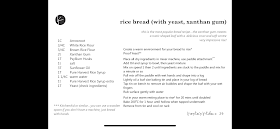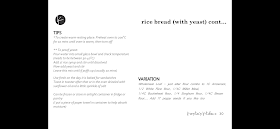 |
| Xanthan Gum Loaf |
Bread (with Yeast)
gluten free, dairy free, egg free, nut free, corn free, soy free, sugar free
suitable for RPAH Elimination and Failsafe diet
Gluten free bread making is a challenge... most available commercially are like rocks, some have a great flavour and taste nice as toast, others are crumbly and inedible. It is possible to have a nice soft gluten free loaf. Nothing will be exactly the same as a bread made with gluten, but you can come very close.
I have two loaves that I really love - white and wholegrain. The wholegrain is probably the closest to 'normal' bread I've ever made. Both are light and able to be eaten as sandwiches when fresh. We have sandwiches the day the bread is baked and then toast for the days after.
If you really want to be able to take a sandwich to school/work, we use bread rolls instead. They are easy to freeze, defrost and quickly refresh in the oven each morning; and they still taste good at lunchtime.
There are a few techniques required to make good bread and it will take practise to master them. We will go through each process with images and I hope this helps you succeed! If your bread does not work, please ask questions and I will do my best to assist. It is worth persevering until you get it... honestly it is!
Firstly, you need a mixer that can handle mixing the dough. You can do it by hand, but it is really hard work. A hand mixer will not work, its motor is not powerful enough. A stand mixer like a KitchenAid is great, as is the awesome Thermomix. I have both and love making bread in either.
Secondly, you need a tin. The recipe makes a small loaf. I use a loaf tin that measures 25 x 13 x 6 (cm). Normally I double the recipe and make a large loaf using a 700g tin from Simply No Knead. (see supplier tab for their details)
STEP ONE
Creating a warm place for your bread to rise
If you live in a warm climate, in summer, you might be able to get away with rising your bread on the window sill. Relying on the weather is not very convenient so I use this method instead.
Preheat oven to 200 degrees celcius... while you make your dough, the oven will warm enough to rise your bread. It should take approx 10 minutes for the oven to get to the correct temp. This is the step most people have issues with and the bread will not rise unless you get this right. Buy an oven thermometer if you need to (very inexpensive at kitchen shops, mine was $10). My oven is about 100 degrees at this point. When you are ready to put in the dough, turn the oven OFF. The remaining warm air in the oven with activate the yeast and rise your bread.
If the oven is too hot, the yeast will die; if the oven is too cold, nothing will happen.
STEP TWO
Proof your yeast
We use LOWAN brand yeast in the red tube. The brands that have sachets have a lot of ingredients added. The tube is handy as you can measure out the quantity you want easily.
You need the correct temp to proof your yeast, if it is too hot, the yeast will die. Water temp needs to be between 30 - 40 degrees. Test with a thermometer. Using your finger to test, you will find the water is tepid, just warm (not quite warm enough for the bath). To achieve this I use some boiling water and some room temperature water. I weigh about 100 - 130g boiling water from the kettle to a glass mixing bowl, then add the remaining weight in cool tap water. Check with the thermometer to make sure the finished water is the right temperature. Adjust if necessary.
Now add your rice syrup. This feeds the yeast to make it activate. You can use sugar, golden syrup whatever you like. We use rice syrup to be cane sugar free. Stir to dissolve the syrup. Now add the yeast and stir briefly to incorporate the yeast into the liquid.
 |
| Yeast ready to proof |
Leave to rest for approx 10 mins until puffy.
 |
| Proofed yeast |
 |
| Side view - proofed yeast |
If the yeast does not look puffed after that time... either the water was too hot/too cold... or the yeast was not fresh. The yeast needs to be fresh. Store your yeast in the fridge or freezer. Throw out the mix and start again with fresh yeast.
While your yeast is getting ready, you can measure out your flours.
STEP THREE
Make dough
TURN OFF YOUR OVEN if you haven't already,
so your warm place doesn't get too hot
Add all the dry ingredients to the bowl... measure carefully
Turn on mixer and combine slowly. It is important to combine all the gums into the flours before adding liquid.
NOTES:
Xanthan Gum - if you are using the xanthan gum recipe, the type of gum is very important. There are several on the market. The one I find to work the best has a very smooth texture and is light in colour... my brand choice is PureVit (they have recently changed their branding to NuVit). Other brands are dark in colour and very grainy. I have not had any success with the grainy xanthan.
Winter - you need to bake with warm ingredients. If your flour is cold, it will not rise. Feel it with your hands and if necessary warm the flour in the microwave briefly to take the chill off.
Once your flours have combined, add your liquid ingredients, including the proofed yeast.
Turn on mixer slowly at first so flour doesn't go everywhere! Increase speed until the dough has come together. It will look like a very thick cake batter.
It will not come away from the bowl like a gluten dough.
The dough is very sticky and you will need wet hands to handle it.
 |
| Dough in KitchenAid Mixer |
 |
| Dough in Thermomix |
Shape your loaf in the tin
Grease your bread tin, then using a spatula, drop all the dough into the tin. Using the spatula, push the dough to the bottom of the tin and shape it like a mountain... so there is a high point down the centre of the tin... make sure you smooth it down and tap the tin on the bench to remove air bubbles.
Dampen the top of the loaf with wet hands to help stop it drying out during the rising process.
 |
| Bread dough - ready to proof |
STEP FIVE
Proof your dough
Gluten free dough only needs one rise. Usually with gluten bread, you would do a first rise, then reshape for the final rise. We don't need to do that.
Place your tin in your warm place. We are using the oven. Check its temperature is still ok. Close the door and wait for approx 15-20 minutes. After that time the bread will have doubled in size.
.JPG) |
| Risen and Ready to Bake! |
If it still looks the same as before, you need to go back through the steps.
Usual problems are:
- yeast was old and didn't proof enough
- not enough liquid was added
- flours were freezing cold
- too much flour was added
- modifications were made to the recipe
- oven was too hot for rising and killed the yeast
- oven was too cold so nothing happened
This is the hardest part of breadmaking and where most people struggle.
STEP SIX
Bake your bread
Leave the bread in the oven and turn it on to the required temperature. The bread will continue to rise as the oven comes back up to temp.
Cook for 40 mins - 1 hour. Depends on your oven... mine takes an hour, others have told me they only need to cook for 40 minutes.
When the bread looks golden, take it out of the tin, and tap it on the bottom. It should sound hollow. If it does then you are all done. Cool on a rack.
 |
| Wholegrain loaf (back) and White Loaf (large loaves) |
Do not slice it until the bread has totally cooled. You can store the bread however you like. In winter I leave it on the bench in a tupperware container. In summer, it is too humid and the bread goes mouldy quickly, so I store it in the same container in the fridge. Slice and freeze if you prefer.
TOLERATE EGG?
Here is another version you can use which uses eggs. For a normal size bread loaf, purchase a large 700g tin from Simply No Knead and make the following amendments to the recipe...
Using the guar gum recipe:
For one small loaf using normal tin
Reduce guar gum to 1t
Add an extra 1/4C white rice flour/buckwheat flour for seed loaf
Add 1 small egg (50-60g)
Proceed with the rest of the recipe as usual
Double the quantities for the large tin
Reduce the guar gum to 2t (instead of 3t)
Add an extra 1/2C white rice flour/buckwheat flour for seed loaf
Add 2 small eggs (50-60g each)
Proceed with the rest of the recipe as usual
PROBLEMS?
If your loaf has sunk in the middle or is wet inside, the dough was too moist. This can happen in summer when it is really humid. Reduce the liquid by 2 tablespoons in this case.
BREAD RECIPES IN THE BOOK
There are a few different bread recipes in the books: Xanthan Gum, CMC, Guar Gum and grain free gluten free seed. The CMC and the Guar Gum loaves look the same. They rise less than the Xanthan, but still have a lovely texture. Xanthan gum is from corn, so if you have a corn allergy, you can use the Guar Gum recipe. The ingredients for the CMC loaf need to be ordered online.
You can make the recipes white or wholemeal. See the variation in the recipe for flour substitutions.
For an impressive rise, make the Xanthan Gum Loaf!
The Xanthan has a mind of its own and rises into an amazing rustic shape. The texture is beautiful and soft.
what else could we make with the same dough?
I use the Guar Gum bread recipe to make these as well...
The Guar loaf does what it is told, and will bake in the exact shape you make it. For this reason I use it to make rolls, focaccia, hot cross buns, sweet and savoury danish. You are only limited by your creativity!
 |
| Use your guar gum dough to make Hot Cross Buns! |
 |
| Pear Danish - using Guar Gum dough |
 |
| Focaccia - divide dough into two, and press down into tins with wet hands, stick fingers in to make indentations... sprinkle with salt flakes. Rise, and bake as per normal recipe. |
 |
| Focaccia - ready to enjoy! |
 |
| Hamburger rolls - we use these for adult and teenager lunches too Just roll the dough into balls with wet hands and place in tins to rise, bake as per normal recipe |
 |
| Mini Rolls - great size for little hands |
 |
| Pita Pockets - see blog post for instructions |
We don't have to miss out on bread when we need to eliminate Gluten from our diets...
Happy Baking!
All bread recipes are in my book... please see the Recipe Book Tab for purchasing details.









